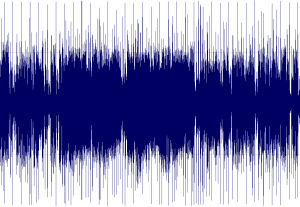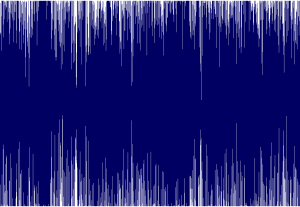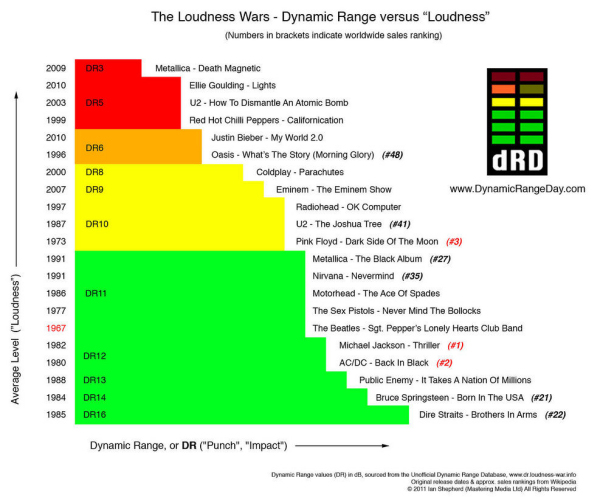Loudness
 See: the Turn Me Up Initiative !
See: the Turn Me Up Initiative !
The Loudness War
The Problem
Over the time period from introducing CDs to today, recorded music is more and more compressed to achieve higher and higher 'loudness'.
 See: Compressor.
See: Compressor.
Louder tracks seem to grab the attention faster. The same problem exists in broadcast audio there advertising clips compete with each other for the highest total sound level. See Loudness Control. But this 'bad behaviour' came up already when FM radio stations started to compete with each other for the loudest music transmission.
As soon as music is automatically played with a fixed volume, as in restaurants or clubs, the higher loudness of a recording has a real advantage in the first view: it is heard louder than the other songs ..
Over-compressed recorded music doesn't sound great! Recordings with too much compression (even the best compression algorithms on the market) lack punch and can sound muddy. Artists who even are aware of the problem don't want to have 'lower' sound levels on their CDs than competing artists have. The "loudness war" is not really a war but a collective move higher and higher to get the last half dB cranked up. The louder - the better - the more excited listeners - the more buyers - the more money .. True? Not really !!
 |
 |
| waveform with 'old fashion' dynamics |
waveform, over-compressed for 'loud' sound |
Actually in music the same is true as for any other recorded sound: the highest peaks should be undistorted. To keep the characteristics of the music piece as it is, the ratio between the RMS level and the peak level (the crest factor) defines how 'loud' the piece finally is, if listened to on a pre-defined level. Any music piece with a lower ration between RMS and peak levels could be turned up more without reaching digital full scale (FS) and hence not distorting. Suddenly songs with more dynamic and more percussive parts and more transients seamed lower in level, powerless, poor sounding, compared to non-dynamic loud songs. This can be a marketing problem. Mastering engineers are in the critical situation to make a song loud but still punchy and good sounding.
 See: Crest Factor and Root Mean Square.
See: Crest Factor and Root Mean Square.
Year after year levels were pushed up more and the mastered CDs of the last years reach average audio levels as high as -3 dBFS.
 |
| the 'loudness war' table by Ian Shepherd (source/image by: Ian Shepherd) |
Audio File Levels compared to Levels of Video Files
Comparing audio tracks and video files the problem is even bigger. Video files always should follow the rules of broadcast engineering, leaving enough headroom above the nominal (RMS) recording level.
 See: Levels.
See: Levels.
As soon as a CD track is converted to a MP3 file, the level is as high as it was on the CD, compared to digital full scale. Comparing this track with a broadcast recording it is way too hot. Inserting a music track into a video production is no problem, the level is just taken down appropriately. But what with a music video? Should it be 'loud' as the CD? Or should it be loud as a regular video clip?
Comparing clips (also professional ones) on YouTube shows the problem very clear: individual clips differ in the overall audio level for up to 18dB. Actually exactly the extremes: full compressed audio close to digital full scale and professionally produced audio -18dB or -12dB below digital full scale.
Movie tracks are recorded with an average level of -20dBFS as defined in the THX standard. This is much lower than any mastered music recording today. With 20dB headroom above the average level there is enough headroom for any dynamic occurance.



